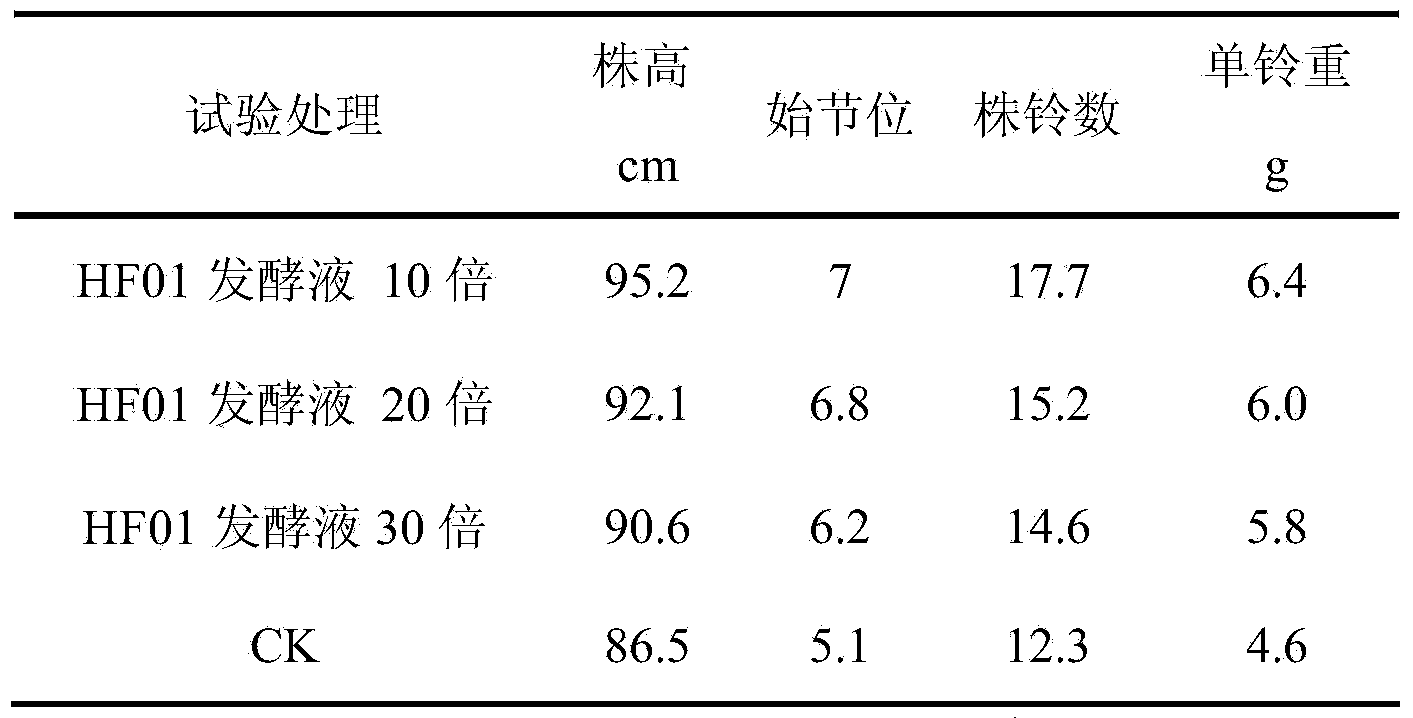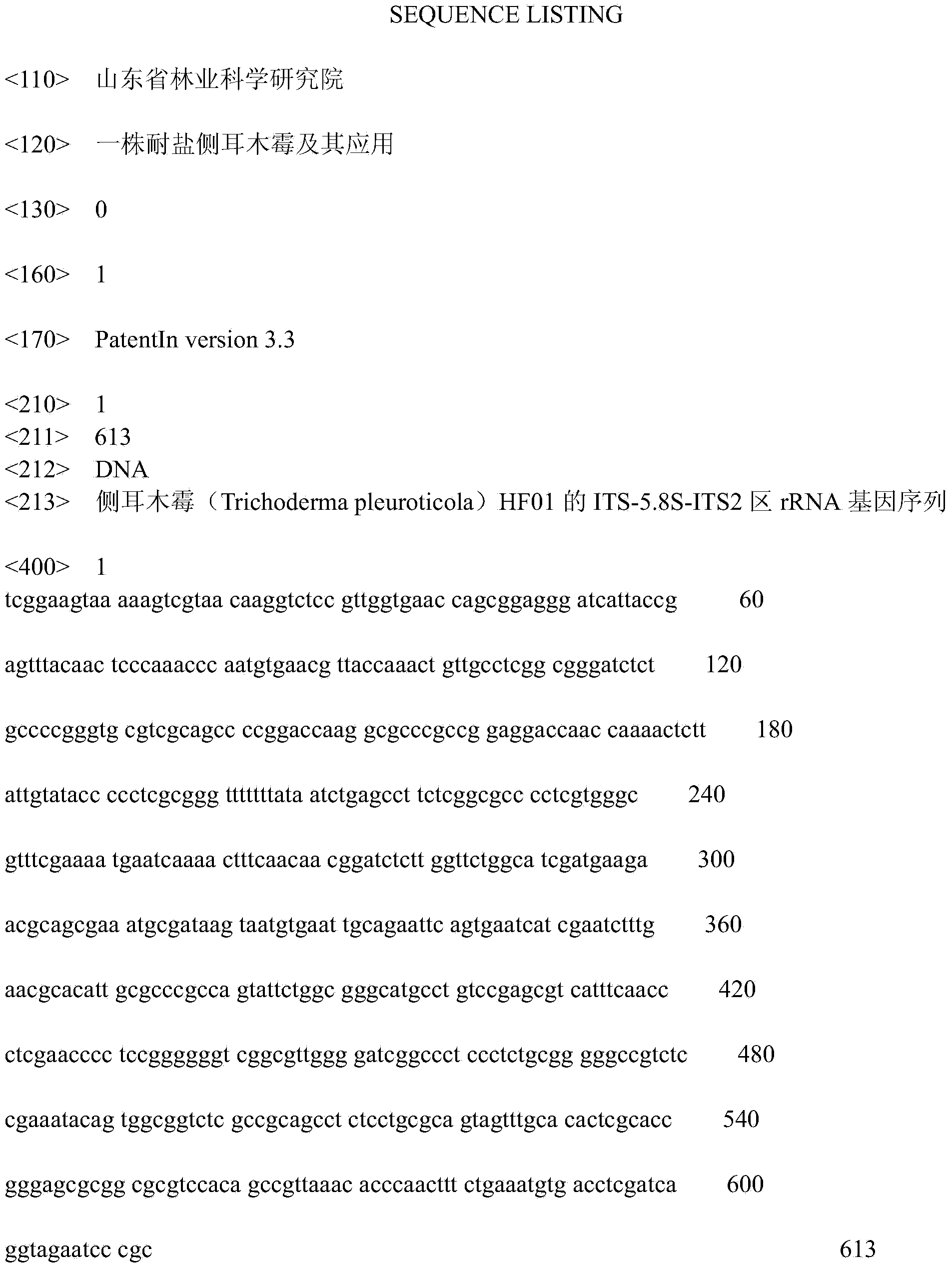Salt-tolerant trichoderma pleuroticola strain and application thereof
A technology of Trichoderma pleurotus and strains, applied in the direction of application, chemicals for biological control, biocides, etc., can solve the problems of difficult absorption and utilization of phosphate by crops, and achieve accelerated prevention and control of plant diseases, good application prospects, and accelerated decomposition straw effect
- Summary
- Abstract
- Description
- Claims
- Application Information
AI Technical Summary
Problems solved by technology
Method used
Image
Examples
Embodiment 1
[0029] 1. Isolation and purification of Trichoderma pleurotica (T.pleuroticola) HF01
[0030] Trichoderma pleuroticola (T.pleuroticola) HF01 of the present invention is obtained from the coastal wetland soil by using the dilution plate method and the plate streaking method to separate and obtain, and the separation method is as follows:
[0031] (1) Isolation of Trichoderma strains: collection of saline soil samples, selecting plots planted with different types of crops in different saline areas of the country, using 5-point sampling method, and collecting the surrounding and central depths of the plots in the range of 10-20cm Appropriate amount of soil inside, mix in equal amount. Indicate the location, time and person of the collection. Weigh 1g of soil sample into 100mL of sterile water, place in a shaker at 30°C at 150rpm for 10min, take 100μL of 10 -2 、10 -3 、10 -4 The dilution was spread on the PDA medium plate, and each gradient was spread in three parallels. After ...
Embodiment 2
[0053] 1. Fermentation process of Trichoderma pleurotus
[0054] PDB medium formula: 200g potato (peeled), 20g glucose, 1000mL distilled water.
[0055] A large amount of solid fermentation medium formula (mass percentage):
[0056] Solid material: composed of rice bran, corn flour and bran with a mass ratio of 75:10:15;
[0057] Inorganic salt solution: 3.5% potassium dihydrogen phosphate, 0.04% magnesium sulfate, 4% ammonium sulfate, and the rest is water.
[0058] The solid-to-liquid ratio is 1:1.8 (mass ratio)
[0059] Mass solid fermentation process of Trichoderma pleuroticola (T.pleuroticola) HF01:
[0060] ① Strain seed liquid culture: Pick a small amount of spores of Trichoderma pleuroticola (T.pleuroticola) HF01 from the slant of the test tube, transfer them to PDB liquid medium, and culture them on a shaker at 28°C for 3-5 days, and this is the seed liquid.
[0061] ②Cultivation of solid production strains: inoculate 10% of the seed solution into solid medium (50...
Embodiment 3
[0064] Trichoderma pleuroticola (Trichoderma pleuroticola) HF01 cotton plot experiment
[0065] Test material: Trichoderma pleuroticola (Trichoderma pleuroticola) HF01 fermentation liquid (the seed liquid obtained in the above step ①), which has the effect of dissolving phosphorus, and the effective number of viable bacteria (viable spores) is greater than 2×10 8 cfu / ml.
[0066] Test time: from April 2012 to October 2012
[0067] Test site: Cotton Center Test Station, Shandong Academy of Agricultural Sciences, Linqing City
[0068] Test crop: Cotton (Lumianyan No. 28)
[0069] Test soil: fluvo-aquic soil
[0070] Experimental design: Trichoderma pleuratus HF01 fermentation broth seed-dressing cotton with different dilutions (10 times, 20 times, 30 times) was used as a demonstration, and the substrate medium-dressed cotton was used as a control (CK), and each treatment was performed in triplicate. The plot area is 20m2, randomly distributed.
[0071] Fertilization amount ...
PUM
| Property | Measurement | Unit |
|---|---|---|
| diameter | aaaaa | aaaaa |
Abstract
Description
Claims
Application Information
 Login to View More
Login to View More - R&D
- Intellectual Property
- Life Sciences
- Materials
- Tech Scout
- Unparalleled Data Quality
- Higher Quality Content
- 60% Fewer Hallucinations
Browse by: Latest US Patents, China's latest patents, Technical Efficacy Thesaurus, Application Domain, Technology Topic, Popular Technical Reports.
© 2025 PatSnap. All rights reserved.Legal|Privacy policy|Modern Slavery Act Transparency Statement|Sitemap|About US| Contact US: help@patsnap.com



